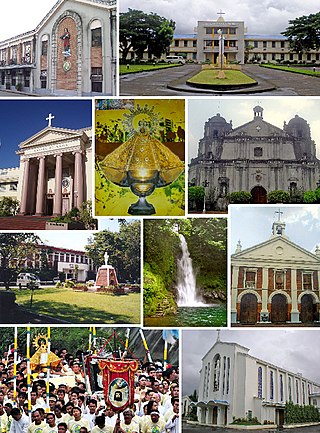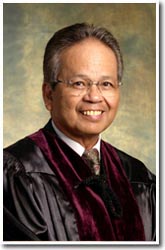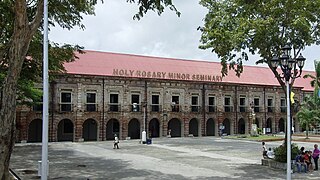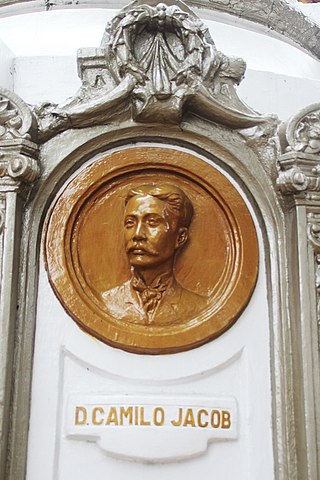
Camarines Sur, officially the Province of Camarines Sur, is a province in the Philippines located in the Bicol Region on Luzon. Its capital is Pili and the province borders Camarines Norte and Quezon to the northwest, and Albay to the south. To the east lies the island province of Catanduanes across the Maqueda Channel.

Camarines Norte, officially the Province of Camarines Norte, is a province in the Philippines located in the Bicol Region in Luzon. Its capital is Daet. The province borders Quezon to the west, Camarines Sur to the south, and the Philippine Sea to the north. It has historically been a Bikol-speaking region. However, there has been a language shift in recent years to Tagalog, which is more commonly used nowadays.

Polangui, officially the Municipality of Polangui, is a 1st class municipality in the province of Albay, Philippines. According to the 2020 census, it has a population of 89,176 people.

Jose Panganiban, officially the Municipality of Jose Panganiban, is a 2nd class municipality in the province of Camarines Norte, Philippines. According to the 2020 census, it has a population of 63,662 people.

Naga, officially the City of Naga, Spanish: Ciudad de Nueva Cáceres, or the Pilgrim City of Naga, is a 1st class independent component city in the Bicol Region of the Philippines. According to the 2020 census, it has a population of 209,170 people.

Iriga, officially the City of Iriga, is a component city in the province of Camarines Sur, Philippines. According to the 2020 census, it has a population of 114,457 people.

Milaor, officially the Municipality of Milaor, is a 3rd class municipality in the province of Camarines Sur, Philippines. According to the 2020 census, it has a population of 33,963 people.

Pili, officially the Municipality of Pili is a 1st class municipality and capital of the province of Camarines Sur, Philippines. According to the 2020 census, it has a population of 99,196 people.

Artemio Villaseñor Panganiban Jr. is a Filipino jurist. He served as the 21st Supreme Court Chief Justice of the Philippines from 2005 to 2007.

Central Bikol, commonly called Bikol Naga or simply as Bikol, is an Austronesian language spoken by the Bicolanos, primarily in the Bicol Region of southern Luzon, Philippines. It is spoken in the northern and western part of Camarines Sur, second congressional district of Camarines Norte, eastern part of Albay, northeastern part of Sorsogon, San Pascual town in Masbate, and southwestern part of Catanduanes. Central Bikol speakers can be found in all provinces of Bicol and it is a majority language in Camarines Sur. The standard sprachraum form is based on the Canaman dialect.

Our Lady of Peñafrancia is an image of the Blessed Virgin Mary in the Philippines. The Marian image is permanently enshrined in the Minor Basilica of Our Lady of Peñafrancia in Naga, Camarines Sur.

The Camarines Sur National High School, also called CamHi, is the oldest national high school in Camarines Sur and one of the biggest public secondary schools in the Bicol Region, Philippines, having a student population of 11,899 in the school year 2021–2022. It was established in 1902.

Jose Ma. Panganiban y Enverga was a Filipino propagandist, linguist, and essayist. He is one of the main writers and contributors for La Solidaridad, writing under the pen names "Jomapa" and "J.M.P."

The Holy Rosary Minor Seminary is the oldest Christian higher educational institute for the clergy in the Philippines established in Naga City, Camarines Sur, in the early part of the 18th century. At present, it houses 114 seminarian interns and 16 extern seminarians from the Diocese of Libmanan. From its reopening in the year 2013 after its closure during the 1980s, accepts Junior High School and Senior High School enrollment in adherence to the K-12 Program of the Department of Education.

The Fifteen Martyrs of Bicol were Filipino patriots in Bicol, Philippines who were executed by firing squad on January 4, 1897, for cooperating with the Katipunan during the Philippine Revolution against Spain.

Holy Rosary Minor Seminary is a Roman Catholic seminary or a house of formation for high school and college would-be priests run by the Archdiocese of Caceres in Naga City, in the Philippines.

The Rizal Monument in Calamba is a monument built to commemorate the sesquicentennial (150th) birth anniversary of Dr. José Rizal, the Philippines' unofficial national hero and the greatest son of Calamba. It is a 6.7 metres (22 ft) statue sculpted by Jonas Roces and is located at The Plaza, a 6.7-hectare (17-acre) park in front of the Calamba City Hall Complex along Bacnotan Road in the barangay of Real. President Benigno Aquino III led the unveiling of the monument on June 19, 2011. The monument was cited as the tallest Rizal monument in the world before former Laguna Governor Jeorge 'E.R.' Ejercito Estregan inaugurated a 26 feet bronze Rizal Monument sculpted by Toym Imao, son of National Artist for Sculpture Abdulmari Asia Imao in Santa Cruz, Laguna, for the 2014 Palarong Pambansa hosted by the province.

The Bikol languages or Bicolano languages are a group of Central Philippine languages spoken mostly in the Bicol Peninsula in the southeastern part of Luzon, the neighboring island-province of Catanduanes, and the island of Burias in Masbate.

Camilo Jacoby Soledad was a Bicolano hero, martyr and revolutionary. He was also known as one of the 11 among the Fifteen Martyrs of Bicol who were executed in Bagumbayan (Luneta), now Rizal Park, by Spanish authorities at the end of 19th century during the Philippine revolution.

Luis Guevara Dato was a Filipino poet, writer, educator and politician from Baao, Camarines Sur. He was one of the first Filipinos to write and publish works in English. Among his poems are "The Spouse", "Day on the Farm" and "Among the Hills". In 1927, his "Mi Ultimo Pensamiento" was the first good English translation, in rhymes, of José Rizal's "Mi último adiós".























